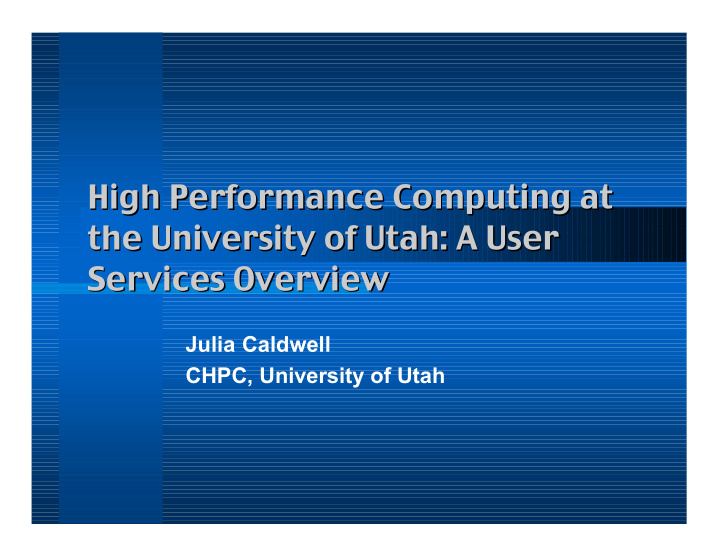



High Performance Computing at High Performance Computing at the University of Utah: A User the University of Utah: A User Services Overview Services Overview Julia Caldwell CHPC, University of Utah
Overview Overview Resources l Research l Staff l User Services l Problem Tracking l User Documentation l Summary and Future Plans l Bonus: The G-Protein Story l
Resources Resources 96 processor SGI Origin 2000 with 8 graphics l pipes 74 node IBM SP l 20 processor SGI PowerChallenge l 32 node Intel Cluster l INSCC Building l
Research Research Avalanche, Scalable Parallel Processor Project l Center for the Simulation of Accidental Fires & Explosions l Combustion and Reacting Flow Modeling l Cosmic Ray Research l Geophysics l Medical Imaging Research Lab l Meteorology l
Research (cont cont.) .) Research ( Quantum Chromodynamics (physics) l SCI Utah - Scientific computing and Imaging (computer l science) Computational Chemistry, Thanh N. Truong l The Voth Group (chemistry) l FOR MORE INFO... http://www.chpc.utah.edu/research
CHPC Staff CHPC Staff Administrative Staff: Director, 3 Assistant Directors and 2 l secretaries Staff Scientists - 5 fte l Systems - 8 fte l Networking - 3 fte l User Services - 7 fte (4 full time, from 5-7 part-time) l FOR MORE INFO... http://www.chpc.utah.edu/general/directory.html
User Services User Services Help Desk - problem tracking l – HPC – INSCC building Consulting l Training - Shortcourses l Quarterly Newsletter l User notification l Library - central location for vendor documentation l
Problem Tracking Problem Tracking Early stages of GNATS implementation l Older combination of 3 systems l Need to do additional staff training in June 1999 l Hope to be in full production by end of August l 1999
User Documentation User Documentation All Web based l UserÕs guide on all major platforms l FAQ l Online forms for account management l In development - web interface to GNATS l
Summary and Future Plans Summary and Future Plans CHPC committed to keeping up with the cutting l edge of high performance computing. Expand the problem tracking system l Expand Training Area l Better library management l
A computer animation A computer animation representing the molecular representing the molecular events of G protein-coupled events of G protein-coupled receptor activation receptor activation Douglas J. Steel, Zoya Maslak, & Jimmy Miklavcic, Robert J. McDermott, University of Utah, Salt Lake City, UT 84112
Introduction Introduction l Simulation: Data Driven l Animation: Story Driven l Expository Animation for Scientific Visualization: An animation that attempts to portray a story to the best of what is the scientific knowledge at the time. Sometimes there is not full agreement on what is the scientific knowledge at the time.
Douglas J. Steel Douglas J. Steel Post-Doctoral Fellow Department of Biology
Introduction (contÕd) Introduction (contÕd) • This animation is accurate in neither: • time • color • scale • shape • dimension • correspondence to data
Introduction (contÕd) Introduction (contÕd) l However, given these conditions we have created this animation to portray an explanation of these phenomena which are consistent with published data.
Zoya Maslak Zoya Maslak Master of Fine Arts Student Art Department
Introduction Introduction • Scientists have images of complex biological processes in his or her imagination, but those images are very different from one another. • Abstract scientific concepts can be depicted by well designed images with careful use of colors, models, textures and motion.
Jimmy Miklavcic Jimmy Miklavcic Multimedia Specialist Center for High Performance Computing
Introduction Introduction l The video media offers an extension to the analysis and visualization of scientific data. l The video production creates a “package” to contain the information and it “frames” the results in a way that it is easily understood. l An archival form, as well as a final product that can be repeatedly viewed and easily distributed.
Robert J. McDermott Robert J. McDermott Staff Scientist for Visualization Center for High Performance Computing
Introduction Introduction l An expository animation project is a long term commitment by dedicated people who have extensive computational resources available. l This project was completed over a year by three principals with Softimage 3D Modeling & Animation Software, SGI Graphics Workstation, SGI Power Challenge, Softimage Digital Studio. l There were significant contributions to this projects in the form of video & audio editing, as well as the composing of original music.
Conclusion Conclusion l Our resulting animation production was well worth the personal effort and the expenditure of computational resources. l Animation well received by researcher community.
Recommend
More recommend